Bromley saw more than its share of the Blitz, which began during the summer of 1940, due to its proximity to both London and the RAF base at Biggin Hill. Biggin Hill was the target of a series of raids, one of which killed 40 people in late August. Bromley town centre was hit by incendiary bombs on September 6th. As British fighter planes began to step up resistance from mid-September, German aircraft would drop their bombs over Bromley as they escaped. In the Chatterton Village area, Havelock Road was bombed twice: number 29 in September 1940, when a man and his 14-year-old daughter were killed, and then a few more homes in early October, when five people were killed at number 60.
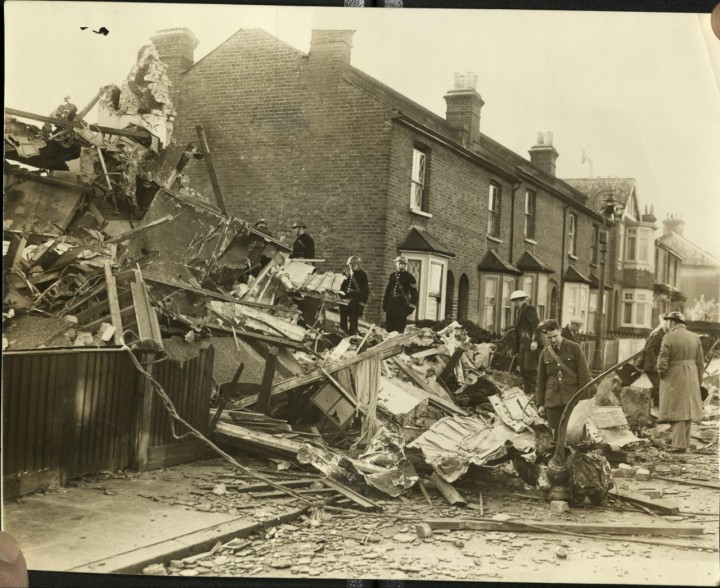
Then, on the night of November 9th, a German bomber crashed into Johnson Road. It may have been due in part to the hubris of the aircraft’s pilot, Leutnant Max Probst, who held London’s anti-aircraft defences in such low regard that he would generally fly straight through its gunfire. On this particular night, however, his aircraft – a Heinkel He 111 – lost most of one wing as it flew across defences in Chislehurst. With the aircraft out of control, he baled out over the Sundridge Park Mansion Hotel, where he was captured, while the He 111 continued its doomed descent with other crew still inside.
One of Johnson Road’s residents described the experience to a newspaper reporter:
“My husband, myself and our four children were in the living room when we heard the plane swooping, and my husband told us to take cover in the cupboard. Then there was a terrific noise, and a smashing of glass. He told us to keep calm, then rushed across the road without waiting to put his hat and coat on.”
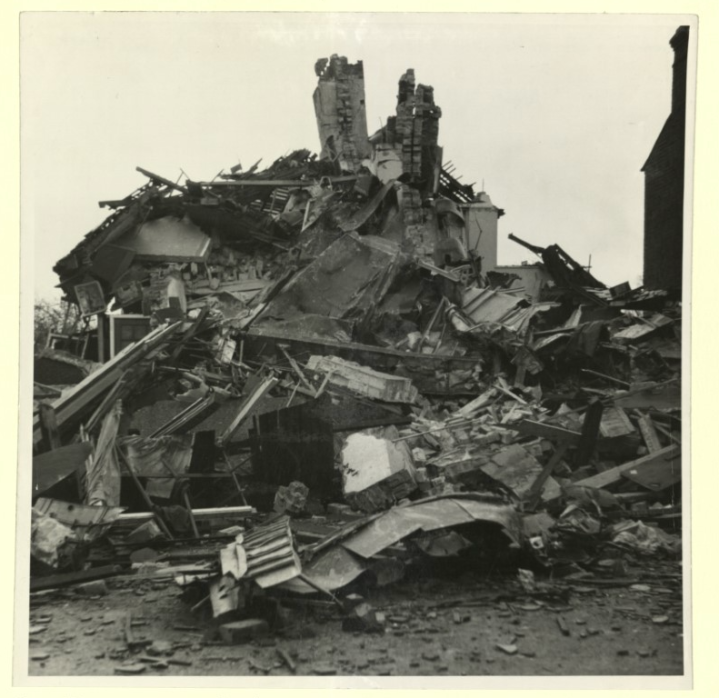
The Heinkel had smashed into 26 and 28 Johnson Road, destroying the two houses. The occupants of one – Mr and Mrs Monday – were trapped beneath the wreckage. Meanwhile two German airmen were dead in the fuselage and another – who had made a too-late attempt to bale moments before the crash – hung by his parachute from the chimney of number 14. He died soon after being got down.
Terrifyingly, among the wreckage were 30 unexploded 50kg bombs and several thousands rounds of ammunition that the Luftwaffe plane had been carrying. Petrol was running down from the twisted fuselage. Much of the street was quickly evacuated although, incredibly, the wreckage did not ignite.
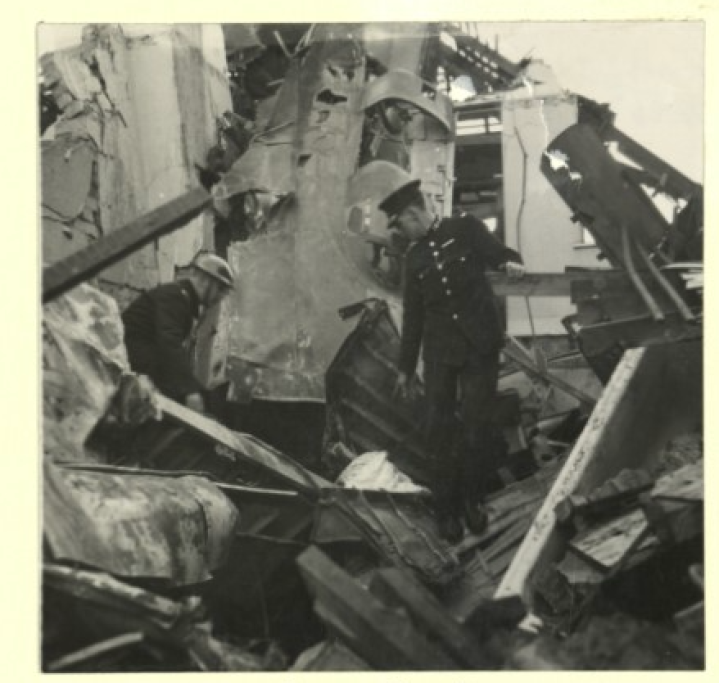
Bromley historian Lewis Blake records:
“The awful truth dawned on everyone at the scene that the whole street faced disaster. As minds worked on how best to tackle the situation, Sergeant David Grigg, a traffic patrol man of P Division, Metropolitan Police, arrived on the scene and volunteered to remove the missiles one by one to open ground across the A21 Hastings Road. One of the bombs was thought to be ticking ominously, but Sgt Grigg nonetheless gingerly carried them to a safe distance from the street’s terraced dwellings.”
Mrs Alice Monday, 31 years old and a cashier at a local cinema, was dead by the time she was pulled out of the wreckage. Her husband, a motor engineer, was taken to hospital and survived. The occupants of the other house, Mr and Mrs A.H. Button, both in their 70s, had a remarkable escape. Mrs Button had been stood in the kitchen doorway and pulled to safety by her husband as the house collapsed.
Mr B.W. Darby, who lived next door to the Mondays and was a member of the stretcher party, told the newspapers: “Mr and Mrs Monday usually shared our Anderson shelter with us and were coming in on Saturday evening. My brother was standing at the back door when he heard the aeroplane coming down, and thought it was a bomb. It sounded like a tornado; he shut the door and threw himself down.
“Immediately after he saw what had happened he tore his way through the fence, went through the broken kitchenette window and tried to force his way through, but was unable to and went to the front where h got on top of the debris. Above the wreckage was what looked like a vapour cloud.
“Mr William Wilson and I, who had been on duty, then came to the scene. We climbed on the wreckage and made a hole in the debris in an endeavour to reach Mr and Mrs Monday. My brother and Mr Wilson removed what bombs they could although petrol was running on them all the time. They could hear Mrs Monday groaning. Soon after the rescue squad arrived and one discovered Mr Monday lying on a bomb.”
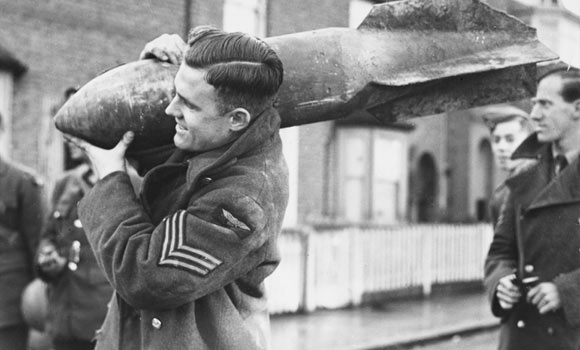
Sgt Grigg was awarded the George Medal in March 1941, in recognition of his heroics, which were recorded in the London Gazette:
“A German aeroplane crashed on two dwelling houses demolishing both and burying the residents. Four persons were rescued,slightly injured. Shortly afterwards, four more bombs were dropped nearby, only a few yards from the Police and Rescue Parties, causing them to suspend operations for a few minutes. When the rescue work was resumed, it was discovered that a number of bombs, several of which were still attached to parts of the machine, were amongst the debris. Two more persons were trapped underneath and it was necessary to remove the bombs before they could be extricated.
“Police Sergeant Grigg volunteered to carry the bombs from the wrecked houses and removed three of them from the wreckage. He was about to return for a fourth when it was suspected that one or more were about to explode. Nevertheless, Grigg again entered the wreckage and removed the bomb. The Sergeant then crawled beneath the debris and located one of the trapped victims, who was eventually rescued. Grigg, who had no special knowledge of bombs, showed great courage and devotion to duty.”
Another individual who put his life at risk was Captain Charles Lea of the 2nd Engineers, who seems to have supervised the safe removal of the rest of the bombs through the night and into the morning. Captain Lea, who later died at Salerno, also received the George Medal, in September 1941. His citation recorded the incident in Johnson Road:
“On the 9th November 1940, a German aeroplane, carrying a load of bombs crashed at Bromley demolishing two houses and trapping certain of the occupants in the debris. Capt. Lea gave immediate assistance regardless of the difficulty and danger involved. Nearly 30 bombs required to be disposed of. Some of them were in the debris and others entangled in the wreckage of the aeroplane. Capt. Lea took the matter in hand himself and in the course of the night and the following morning, by skilfull and courageous work, he completed the disposal of all the bombs, so making it possible for the rescue of the trapped persons to proceed in safety. This case is typical of many others in which the gallantry of this Officer has been a safeguard in the whole neighbourhood.”
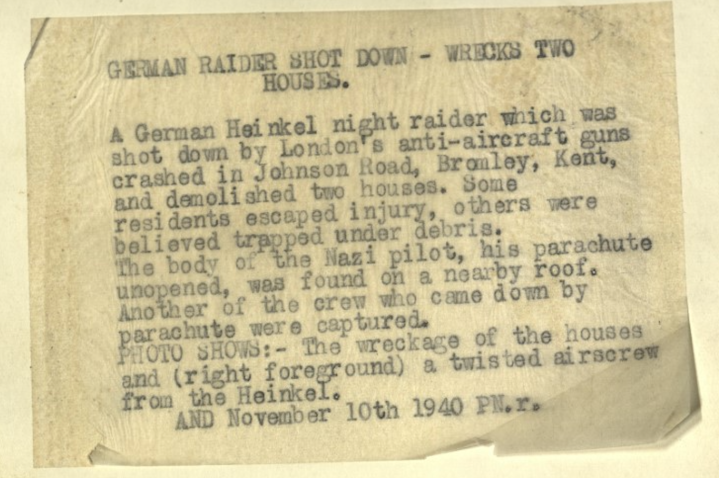
One more individual involved in the response that night also received the George Medal. Dr Kenneth Tapper – head of Bromley casualty services – climbed amongst the wreckage and the unexploded bombs to treat those who were trapped. Dr Tapper, a New Zealander, was said to have performed this feat on various occasions before. His citation read:
“Dr Tapper has on many occasions during enemy attacks crawled under wreckage to search for and give treatment to injured casualties pinned down by debris. When people were buried beneath the wreckage of a German aeroplane and two houses Dr Tapper gave medical aid to the victims whilst large unexploded bombs were removed. Dr Tapper has shown great gallantry in his efforts to relieve suffering amongst air raid victims.”
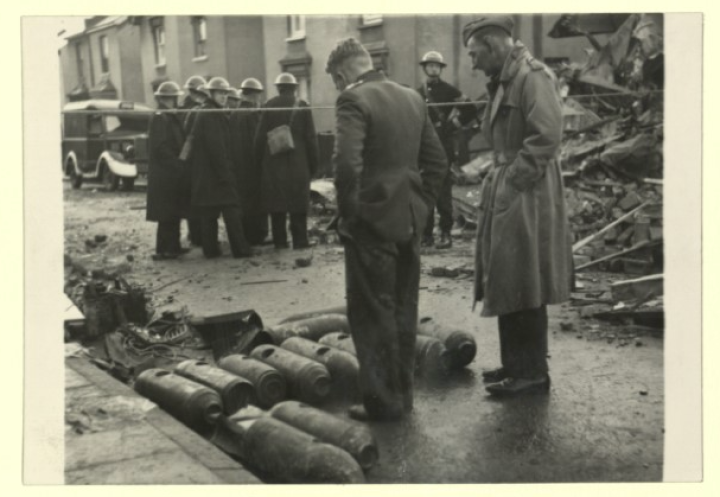
Sources: Lewis Blake, Bromley in the Front Line (1980); Graham Reeves, Undaunted: The Story of Bromley in the Second World War (1990).
Thanks to Brinley Hawkins for discovering and sharing the images featured above.